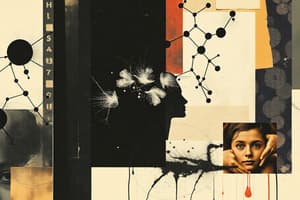Podcast
Questions and Answers
What is the primary structural feature of amphipathic compounds?
What is the primary structural feature of amphipathic compounds?
- They are exclusively water soluble.
- They have only polar portions.
- They consist solely of hydrophobic tails.
- They have distinct polar and non-polar portions. (correct)
In a micelle formation, which parts of the amphipathic molecules are oriented towards the water?
In a micelle formation, which parts of the amphipathic molecules are oriented towards the water?
- Hydrophobic parts face out to interact with water.
- Non-polar parts cluster together.
- Hydrophilic parts face out towards the water. (correct)
- Both parts are equally distributed in water.
What are the main components of a phospholipid bilayer?
What are the main components of a phospholipid bilayer?
- Lipid tails and sugar molecules.
- Phosphoglycerides and proteins. (correct)
- Fatty acids and glycoproteins.
- Phosphoglycerides and cholesterol.
How do liposomes deliver drugs to specific cells?
How do liposomes deliver drugs to specific cells?
Which type of bond has the highest bond energy as listed?
Which type of bond has the highest bond energy as listed?
What property of water is primarily responsible for its ability to dissolve polar compounds?
What property of water is primarily responsible for its ability to dissolve polar compounds?
Which statement is true about hydrophilic and hydrophobic substances?
Which statement is true about hydrophilic and hydrophobic substances?
What occurs during the reduction process in a chemical reaction?
What occurs during the reduction process in a chemical reaction?
In the context of biochemical processes, what does a negative Gibbs free energy change (∆G < 0) indicate?
In the context of biochemical processes, what does a negative Gibbs free energy change (∆G < 0) indicate?
Which of the following correctly describes the electronegativity trend among the listed elements?
Which of the following correctly describes the electronegativity trend among the listed elements?
Which type of compounds typically exhibit hydrophobic properties?
Which type of compounds typically exhibit hydrophobic properties?
What describes the interaction in hydrogen bonds?
What describes the interaction in hydrogen bonds?
Which statement is false regarding oxidation and reduction reactions?
Which statement is false regarding oxidation and reduction reactions?
Flashcards are hidden until you start studying
Study Notes
Water and Hydrogen Bonds
- Water is highly polar due to the unequal sharing of electrons between oxygen and hydrogen atoms.
- The difference in electronegativity creates partial negative and positive charges, making water a polar molecule.
- This polarity influences water's solvent properties, allowing it to dissolve polar compounds and interact strongly with itself.
- Hydrogen bonds form between polar groups and water molecules.
- A hydrogen bond donor (partially positive hydrogen atom) interacts with a lone pair of electrons on a hydrogen bond acceptor (electronegative atom).
- Hydrogen bonds are crucial for many biological molecules, such as nucleotides.
Oxidation/Reduction Reactions
- Reduction involves the gain of electrons.
- Oxidation involves the loss of electrons.
- An example of an oxidation-reduction reaction is the reaction of H3CHC=O with NADH + H+ to form H3CH2COH + NAD+.
Spontaneity of Life Processes and Free Energy
- Biochemical processes occur spontaneously based on the Gibbs free energy change (∆G).
- ∆G = ∆H - T∆S, where ∆H is the enthalpy change, T is the temperature, and ∆S is the entropy change.
- If ∆G < 0, the reaction will occur spontaneously in the forward direction.
- If ∆G > 0, the reaction will not occur spontaneously.
- If ∆G = 0, the reaction is at equilibrium.
Hydrophilic & Hydrophobic Substances
- Hydrophilic (water-loving) compounds dissolve readily in water.
- Hydrophobic (water-fearing) compounds separate from water.
- Examples of hydrophilic compounds include ionic compounds, polar organic compounds, weak acids, and sugars.
- Examples of hydrophobic compounds include nonpolar hydrocarbons and lipids.
- Hydrophobic effects are crucial for life, contributing to the formation of folded proteins, nucleic acids, and membranes.
Amphipathic Substances
- Amphipathic (both feeling) or amphiphilic (both loving) compounds have distinct polar (water-soluble) and non-polar portions.
- An example is a fatty acid.
Soap's Amphipathic Molecules
- Soap molecules, being amphipathic, form micelles when in water.
- Micelles are spherical clusters of amphipathic molecules where the hydrophobic parts cluster away from water and the hydrophilic parts face outward.
- Soap micelles trap non-water-soluble oils and grime within their core.
Phospholipid Bilayers
- Phospholipid bilayers are the basis of cell membranes.
- Phosphoglycerides are the main component of phospholipids.
- The tails of phospholipids are typically 16-18 carbons long.
- Phospholipid compositions vary, and bilayers are asymmetric.
- Phospholipid bilayers are self-sealing.
Liposomes
- Liposomes are artificial vesicles.
- Water-soluble drugs can be enclosed in the core of a liposome, while fat-soluble drugs can be incorporated into the lipid bilayer.
- Surface sugars on liposomes can prevent destruction by the immune system.
- Liposomes can be engineered with targeting proteins to deliver drugs to specific cells.
Protein Folding Based On Hydrophobicity
- Protein folding is influenced by hydrophobicity.
- Hydrophobic amino acids tend to cluster together in the interior of proteins.
- This clustering helps reduce the contact of hydrophobic groups with water.
- Folding is a complex process driven by multiple interactions.
Bond Energies and Strength
- Covalent bonds are strong and involve the sharing of electrons.
- Examples include:
- C-H (413 kJ/mol)
- O-H (460 kJ/mol)
- Noncovalent bonds are weaker and involve interactions between molecules.
- Examples include:
- Hydrophobic interaction (4-12 kJ/mol)
- Hydrogen bond (20 kJ/mol)
- Ion-dipole interaction (20 kJ/mol)
Studying That Suits You
Use AI to generate personalized quizzes and flashcards to suit your learning preferences.




